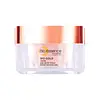What's inside
What's inside
 Key Ingredients
Key Ingredients

 Benefits
Benefits

 Concerns
Concerns

 Ingredients Side-by-side
Ingredients Side-by-side

Water
Skin ConditioningGlycerin
HumectantCyclopentasiloxane
EmollientCetearyl Dimethicone/Vinyl Dimethicone Crosspolymer
EmollientOlive Oil PEG-7 Esters
EmollientNiacinamide
SmoothingEuglena Gracilis Extract
Skin ConditioningBiosaccharide Gum-1
HumectantPentylene Glycol
Skin ConditioningRosa Damascena Flower Water
MaskingRosa Damascena Flower Oil
MaskingPseudoalteromonas Ferment Extract
HumectantSodium Hyaluronate
HumectantFructose
HumectantUrea
BufferingCitric Acid
BufferingSodium Hydroxide
BufferingMaltose
MaskingSodium PCA
HumectantSodium Chloride
MaskingSodium Lactate
BufferingTrehalose
HumectantAllantoin
Skin ConditioningGlucose
HumectantTocopherol
AntioxidantSodium Carbomer
Emulsion StabilisingSodium Salicylate
PreservativeDisodium EDTA
Phenoxyethanol
PreservativeChlorphenesin
AntimicrobialCI 45410
Cosmetic ColorantGold
Cosmetic ColorantWater, Glycerin, Cyclopentasiloxane, Cetearyl Dimethicone/Vinyl Dimethicone Crosspolymer, Olive Oil PEG-7 Esters, Niacinamide, Euglena Gracilis Extract, Biosaccharide Gum-1, Pentylene Glycol, Rosa Damascena Flower Water, Rosa Damascena Flower Oil, Pseudoalteromonas Ferment Extract, Sodium Hyaluronate, Fructose, Urea, Citric Acid, Sodium Hydroxide, Maltose, Sodium PCA, Sodium Chloride, Sodium Lactate, Trehalose, Allantoin, Glucose, Tocopherol, Sodium Carbomer, Sodium Salicylate, Disodium EDTA, Phenoxyethanol, Chlorphenesin, CI 45410, Gold
Water
Skin ConditioningDicaprylyl Carbonate
EmollientNiacinamide
SmoothingBetaine
HumectantC12-15 Alkyl Benzoate
AntimicrobialGlycerin
HumectantOctyldodecanol
EmollientHydroxyethyl Acrylate/Sodium Acryloyldimethyl Taurate Copolymer
Emulsion StabilisingPhenoxyethanol
PreservativeTocopheryl Acetate
AntioxidantOctyldodecyl Xyloside
EmulsifyingPEG-30 Dipolyhydroxystearate
EmulsifyingButylene Glycol
HumectantCaprylyl Glycol
Emollient3-O-Ethyl Ascorbic Acid
Skin ConditioningAscorbyl Tetraisopalmitate
AntioxidantPolysorbate 60
EmulsifyingSorbitan Isostearate
EmulsifyingParfum
MaskingDipropylene Glycol
HumectantLimonene
PerfumingCitrus Junos Fruit Extract
Skin ConditioningBenzyl Benzoate
AntimicrobialHexyl Cinnamal
PerfumingLinalool
PerfumingBenzyl Salicylate
PerfumingXylose
HumectantDenatonium Benzoate
MaskingCI 14700
Cosmetic ColorantCI 19140
Cosmetic ColorantWater, Dicaprylyl Carbonate, Niacinamide, Betaine, C12-15 Alkyl Benzoate, Glycerin, Octyldodecanol, Hydroxyethyl Acrylate/Sodium Acryloyldimethyl Taurate Copolymer, Phenoxyethanol, Tocopheryl Acetate, Octyldodecyl Xyloside, PEG-30 Dipolyhydroxystearate, Butylene Glycol, Caprylyl Glycol, 3-O-Ethyl Ascorbic Acid, Ascorbyl Tetraisopalmitate, Polysorbate 60, Sorbitan Isostearate, Parfum, Dipropylene Glycol, Limonene, Citrus Junos Fruit Extract, Benzyl Benzoate, Hexyl Cinnamal, Linalool, Benzyl Salicylate, Xylose, Denatonium Benzoate, CI 14700, CI 19140
Ingredients Explained
These ingredients are found in both products.
Ingredients higher up in an ingredient list are typically present in a larger amount.
Glycerin is already naturally found in your skin. It helps moisturize and protect your skin.
A study from 2016 found glycerin to be more effective as a humectant than AHAs and hyaluronic acid.
As a humectant, it helps the skin stay hydrated by pulling moisture to your skin. The low molecular weight of glycerin allows it to pull moisture into the deeper layers of your skin.
Hydrated skin improves your skin barrier; Your skin barrier helps protect against irritants and bacteria.
Glycerin has also been found to have antimicrobial and antiviral properties. Due to these properties, glycerin is often used in wound and burn treatments.
In cosmetics, glycerin is usually derived from plants such as soybean or palm. However, it can also be sourced from animals, such as tallow or animal fat.
This ingredient is organic, colorless, odorless, and non-toxic.
Glycerin is the name for this ingredient in American English. British English uses Glycerol/Glycerine.
Learn more about GlycerinNiacinamide is a multitasking form of vitamin B3 that strengthens the skin barrier, reduces pores and dark spots, regulates oil, and improves signs of aging.
And the best part? It's gentle and well-tolerated by most skin types, including sensitive and reactive skin.
You might have heard of "niacin flush", or the reddening of skin that causes itchiness. Niacinamide has not been found to cause this.
In very rare cases, some individuals may not be able to tolerate niacinamide at all or experience an allergic reaction to it.
If you are experiencing flaking, irritation, and dryness with this ingredient, be sure to double check all your products as this ingredient can be found in all categories of skincare.
When incorporating niacinamide into your routine, look out for concentration amounts. Typically, 5% niacinamide provides benefits such as fading dark spots. However, if you have sensitive skin, it is better to begin with a smaller concentration.
When you apply niacinamide to your skin, your body converts it into nicotinamide adenine dinucleotide (NAD). NAD is an essential coenzyme that is already found in your cells as "fuel" and powers countless biological processes.
In your skin, NAD helps repair cell damage, produce new healthy cells, support collagen production, strengthen the skin barrier, and fight environmental stressors (like UV and pollution).
Our natural NAD levels start to decline with age, leading to slower skin repair, visible aging, and a weaker skin barrier. By providing your skin niacinamide, you're recharging your skin's NAD levels. This leads to stronger, healthier, and younger looking skin.
Another name for vitamin B3 is nicotinamide. This vitamin is water-soluble and our bodies don't store it. We obtain Vitamin B3 from either food or skincare. Meat, fish, wheat, yeast, and leafy greens contain vitamin B3.
The type of niacinamide used in skincare is synthetically created.
Learn more about NiacinamidePhenoxyethanol is a preservative that has germicide, antimicrobial, and aromatic properties. Studies show that phenoxyethanol can prevent microbial growth. By itself, it has a scent that is similar to that of a rose.
It's often used in formulations along with Caprylyl Glycol to preserve the shelf life of products.
Water. It's the most common cosmetic ingredient of all. You'll usually see it at the top of ingredient lists, meaning that it makes up the largest part of the product.
So why is it so popular? Water most often acts as a solvent - this means that it helps dissolve other ingredients into the formulation.
You'll also recognize water as that liquid we all need to stay alive. If you see this, drink a glass of water. Stay hydrated!
Learn more about Water